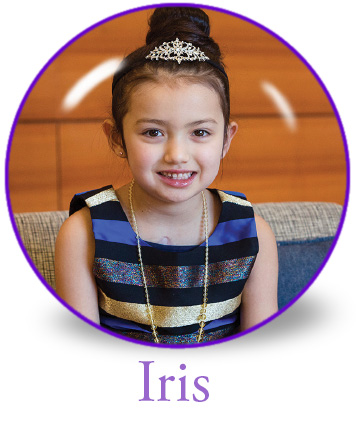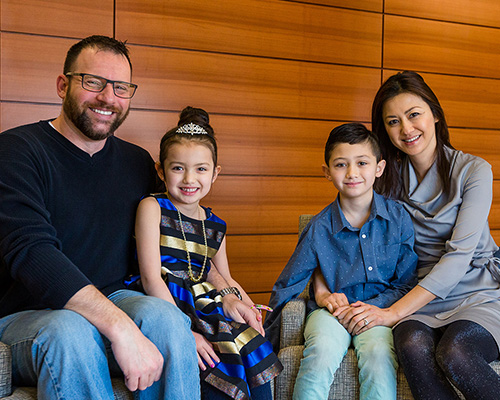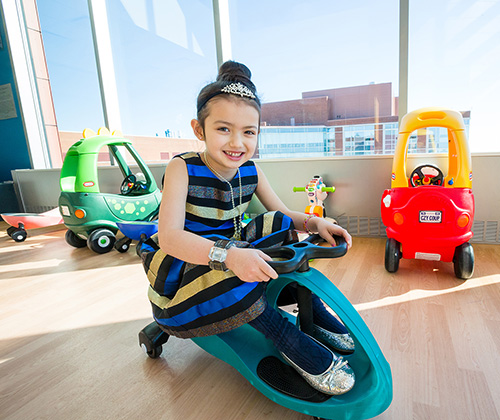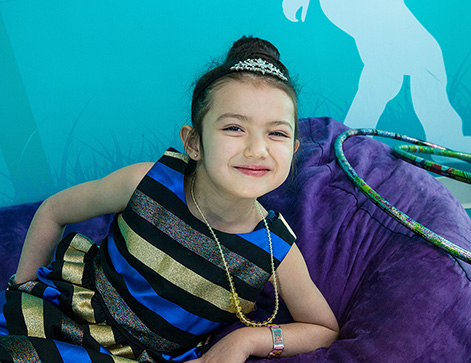Iris Helfner
Defying the odds, “Fighting Iris” bounces back after cardiac arrest
 “He’s in room one! Go get him!”
“He’s in room one! Go get him!”
Karl Helfner was jolted out of sleep by the sound of someone shouting. He had been dozing peacefully in the Ronald McDonald House, just a short walk away from where his 5-year-old daughter, Iris, was recovering from heart surgery.
“What room did they say?” he thought sleepily. “I wonder what’s wrong. It can’t be Iris, can it?”
He listened as loud, running footsteps echoed through the hallway toward his room. Fear and panic gripped him as someone began knocking forcefully on his door.
“You need to come downstairs now,” came the shouts from the other side. “Her heart stopped.” Karl raced to get dressed and ran to the Pediatric Cardiac Intensive Care Unit (PCICU). By the time he arrived, nearly 20 doctors and nurses were in his daughter’s room, trying to restart her heart. He watched through big glass windows as Jill Cholette, M.D., chief of the PCICU, used a defibrillator to shock Iris’s heart four times.
But Iris didn’t respond.
A unique beginning
Iris’s parents often joke that they knew right from the start that their daughter’s journey would be anything but ordinary. Just hours after Iris was born, she was making headlines—because she had arrived at exactly 11:11 a.m. on Nov. 11, 2011.
“All t hose 11s. We kept saying, what are the odds?” said Karl. “Everybody was telling us that she was going to be a lucky baby.”
hose 11s. We kept saying, what are the odds?” said Karl. “Everybody was telling us that she was going to be a lucky baby.”
But the Helfners’ elation dwindled when a pediatrician placed a stethoscope on Iris’s chest. The doctor’s worried expression gave it away: something was wrong.
After more tests, Iris was diagnosed with Ebstein’s Anomaly, a rare congenital heart defect. The valve between her two right heart chambers was not in its proper position, and it had abnormal valve leaflets — flaps of tissue that open and close to allow for blood flow. Despite her diagnosis, Iris was acting like a normal, healthy newborn, so instead of performing surgery right away, doctors chose to keep a close eye on her heart. Every few months, she returned to the hospital for scans, and for years, she was able to avoid the operating room.
But the faulty valve in Iris’s heart began showing too much wear and tear after Iris reached kindergarten. In late 2016, doctors decided it was time for surgery.
George Alfieris, M.D., performed an eight-hour open-heart operation to replace the valve in Iris's heart and allow it to function normally. At first, Iris bounced back from the surgery quickly. Within 24 hours, she was breathing on her own, and she was on track to leave the hospital in about a week.
“She was doing so well that night after the surgery,” said Karl. “So well, that everyone went home, except me.”
A few hours later, her heart stopped.
Fighting Iris
 To keep Iris alive, doctors opened up her chest right in her hospital room. Taking turns, they used their hands to squeeze Iris’s heart and beat it for her—performing what’s called cardiac massage.
To keep Iris alive, doctors opened up her chest right in her hospital room. Taking turns, they used their hands to squeeze Iris’s heart and beat it for her—performing what’s called cardiac massage.
Just a few feet away, Karl watched helplessly as he tried desperately to reach his wife, Kaori, who was sleeping at home.
“Once I got a hold of a friend to run to the house and get her, they flew here,” said Karl. “We were both just shaking.”
Alfieris and Cholette kept Iris’s heart beating for more than an hour and a half, until she could be placed on an advanced life support system called extracorporeal membrane oxygenation (ECMO). The machine pumped Iris’s blood for her, and would hopefully give her heart time to recover.
The extreme panic of the previous hours had lifted a little, but Iris wasn’t out of the woods yet. Children who are sick enough to need ECMO have a 50 percent chance of survival, and over the next week, Iris faced a fair share of challenges.
First, the steady dose of blood thinners that Iris was on to prevent clotting of the ECMO system led to bleeding complications. She needed multiple transfusions and had to make a return trip to the operating room to control the bleeding.
Then she developed unexplained fevers and underwent countless tests and treatments as doctors tried to keep an infection from taking hold.
Next, a clot developed under Iris’s new valve, rendering two-thirds of it ineffective. She was sent to the catheterization lab for another procedure.
“I got to the point where I craved boredom,” said Karl. “It was just one thing after another, after another. But she refused to give up.”
A true miracle
Iris’s body rebounded after each setback, but how her brain had handled the ordeal of the past weeks—and whether it was functioning at all—remained unknown.
 “We were extremely worried about the cognitive delays she might have,” said Cholette. “Whenever cardiac massage is necessary, there is a risk of brain damage. Nothing is the same as the heart beating for itself, and 90 minutes is a very long time.”
“We were extremely worried about the cognitive delays she might have,” said Cholette. “Whenever cardiac massage is necessary, there is a risk of brain damage. Nothing is the same as the heart beating for itself, and 90 minutes is a very long time.”
The Helfners were constantly asking themselves: Would Iris recognize them? Would she even know her name?
To help give them some answers, doctors allowed Iris to wake up temporarily from the medications that were keeping her asleep so Karl could try communicating with her. He asked her a question, and even though Iris still had a tube down her throat and wasn’t able to speak, she mouthed her response. Immediately, Karl knew she was OK.
“I don’t think words can describe how thrilled I was,” said Karl. “Underneath all of the tubes and the IVs, she was still there.”
After nearly two weeks on life support, Iris was able to come off ECMO, and her heart began beating by itself again. Her recovery was slow, and she had to fight past additional obstacles, including a stroke and one last trip to the OR—this time, for the placement of a pacemaker that will help regulate her heart rhythm for the rest of her life.
But day by day, Iris made progress. Soon, she was trading in her feeding tubes and dressing changes for new hairdos and nail polish.
Seventy-two days after her surgery, Iris was finally able to leave the hospital.
“You could tell that it was a celebration for everyone who had cared for her. They had seen her at her worst, and everything that could have gone wrong, did,” said Karl. “But in the end, she was OK.”
Now, just over a year after her hospital stay, Iris is a vivacious first-grader who seems to never stop smiling. The only sign of what she’s been through is a scar down the middle of her chest.
“Her parents stayed so positive through the most extreme, horrible circumstances, and their outlook played a key role in her recovery,” said Cholette. “She is one of the truest miracles I have ever seen.”